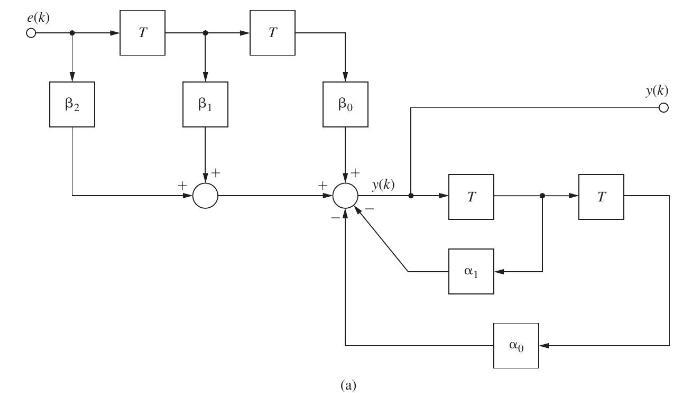Given the second-order digital-filter transfer function [ D(z)=frac{2 z^{2}-2.4 z+0.72}{z^{2}-1.4 z+0.98} ] (a) Find the coefficients of
Question:
Given the second-order digital-filter transfer function
\[ D(z)=\frac{2 z^{2}-2.4 z+0.72}{z^{2}-1.4 z+0.98} \]
(a) Find the coefficients of the 3D structure of Fig. P2.8-1 such that \(D(z)\) is realized.
(b) Find the coefficients of the ID structure of Fig. P2.8-1 such that \(D(z)\) is realized.
(c) Find the coefficients of the IX structure of Fig. P2.8-2 such that \(D(z)\) is realized. The coefficients are identified in Problem 2.8-2.
(d) Use MATLAB to verify the partial-fraction expansions in part (c).
(e) Verify the results in part (c) using Mason's gain formula.
Fig. P2.8-1


Problem 2.8-2
Shown in Fig. P2.8-2 is the second-order digital-filter structure 1X. This structure realizes the filter transfer function
\[
D(z)=b_{2}+\frac{A}{z-p}+\frac{A^{*}}{z-p^{*}}
\]
where \(p\) and \(p^{*}\) (conjugate of \(p\) ) are complex. The relationships between the filter coefficients and the coefficients in Fig. P2.8-2 are given by
\[
\begin{array}{ll}
g_{1}=\operatorname{Re}(p) & g_{3}=-2 \operatorname{Im}(A) \\
g_{2}=\operatorname{Im}(p) & g_{4}=2 \operatorname{Re}(A)
\end{array}
\]
Fig. P2.8-2

Step by Step Answer:

Digital Control System Analysis And Design
ISBN: 9781292061221
4th Global Edition
Authors: Charles Phillips, H. Nagle, Aranya Chakrabortty





